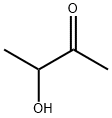-
外観
白色~うすい黄色粉末~結晶
-
種類
アセトインは、主に研究開発用試薬製品や、香料として販売されています。
1. 研究開発用試薬製品
研究開発用試薬製品としては、5g、25g、50g、100g、250g、500g、1kgなど、様々な容量の種類があります。実験室で取り扱いやすい容量を中心に販売されている物質です。通常、冷凍もしくは冷蔵 (2-8℃) で販売されています。
2. 香料
香料としては、産業用・業務用に提供されている物質です。製品詳細については、メーカーへの個別の問い合わせが必要です。
-
性質
アセトインは、分子量88.11、融点15 ℃、沸点148 ℃であり、常温での外観は、無色から微黄色の液体です。
臭いは、 バターのような臭いと形容されます。密度は1.02g/mLであり、水、エタノール、プロピレングリコール、エーテル、ジクロロメタンなどに容易に溶解します。炭化水素溶媒には微溶です。
-
解説
アセトイン,芳香をもつ無色または微黄色の液体.ラセミ体は融点15 ℃,沸点148 ℃.d174 0.9972.n17D1.4190.水,エタノールに易溶.フェーリング液を還元する.放置すると容易に二量化し,光学活性体は不活性化する.二量体は蒸留により単量体に戻る.食品の香料として利用される.[CAS 513-86-0]
森北出版「化学辞典(第2版)
-
用途
バター,チーズ,コーヒー,果実フレーバーなど数多くの食品香料用
-
製造
アセトイン,ビアセチルを亜鉛と酸で部分還元して合成され,またソルボースの発酵生成物としても得られる.
-
合成
アセトインの合成方法には、チアゾリウム塩触媒を用いたアセトアルデヒドのベンゾイン縮合や、酢酸エステルのアシロイン縮合などの方法が挙げられます。
その他に、2,3-ブタンジオールの微生物酸化や、鉛と酸を用いたジアセチル (2,3-ブタンジオン)の部分還元などによっても合成することが可能です。糖を用いる方法では、ソルボースを発酵させ、その発酵生成物としてアセトインを得る方法があります。
-
化学的特性
Acetoin is a yellowish liquid with a bland, woody, yogurt odor and a fatty creamy “tub” butter taste. It is useful as a
flavor ingredient in butter, milk, yogurt or strawberry flavors.
-
天然物の起源
Reported found in fresh apple, butter, cheddar cheese, coffee, cocoa, honey, wheat bread and wine
-
使用
Acetoin is a produced via fermentation of wines, dairy products and sugars by fermentive bacteria. Acetoin is used in food flavoring and fragrances and is also found in some fruits and vegetables.
-
定義
ChEBI: A methyl ketone that is butan-2-one substituted by a hydroxy group at position 3.
-
一般的な説明
A light-yellow colored liquid. Slightly denser than water. Hence sinks in water. Boiling point 280°F. Flash point between 100 and 141°F. Used to make other chemicals.
-
空気と水の反応
Flammable. Slightly soluble in water.
-
反応プロフィール
3-Hydroxy-2-butanone is a ketone and alcohol. Ketones are reactive with many acids and bases liberating heat and flammable gases (e.g., H2). The amount of heat may be sufficient to start a fire in the unreacted portion of the ketone. Ketones react with reducing agents such as hydrides, alkali metals, and nitrides to produce flammable gas (H2) and heat. Ketones are incompatible with isocyanates, aldehydes, cyanides, peroxides, and anhydrides. They react violently with aldehydes, HNO3, HNO3 + H2O2, and HClO4. Flammable and/or toxic gases are generated by the combination of alcohols with alkali metals, nitrides, and strong reducing agents. They react with oxoacids and carboxylic acids to form esters plus water. Oxidizing agents convert them to aldehydes or ketones. Alcohols exhibit both weak acid and weak base behavior. They may initiate the polymerization of isocyanates and epoxides.
-
健康ハザード
Inhalation or contact with material may irritate or burn skin and eyes. Fire may produce irritating, corrosive and/or toxic gases. Vapors may cause dizziness or suffocation. Runoff from fire control may cause pollution.
-
火災危険
HIGHLY FLAMMABLE: Will be easily ignited by heat, sparks or flames. Vapors may form explosive mixtures with air. Vapors may travel to source of ignition and flash back. Most vapors are heavier than air. They will spread along ground and collect in low or confined areas (sewers, basements, tanks). Vapor explosion hazard indoors, outdoors or in sewers. Runoff to sewer may create fire or explosion hazard. Containers may explode when heated. Many liquids are lighter than water.
-
化学反応
アセトインを室温で放置すると、徐々に二分子間でカルボニル基にヒドロキシ基が付加して、ヘミアセタール化した二量体が得られます (2,5-ジメチル-1,4-ジオキサン-2,5-ジオール)。
この二量体生成物は融点 90°Cの結晶性物質ですが、融点以上に加熱することで単量体へ変化させることが可能です。
-
使用用途
アセトインの主な使用用途は、香料です。食品添加物として認められており、広く用いられています。アセトインの香りは、バターやヨーグルトに似た独特のにおいです。この性質を利用して、主にお菓子、マーガリン、コーヒー、キャラメル、タバコ、乳製品に添加されています。
天然ではその他に、主に発酵食品に香りの成分として含まれていますが、野菜や果物にも少量含まれています。
-
法規制情報
アセトインは、 引火性液体および蒸気であり、GHS区分において引火性液体: 区分3に指定されています。熱、火花、裸火、高温のもののような着火源から遠ざけ、容器を密閉して保管することが必要です。
法令においては、労働安全衛生法で危険物・引火性の物に指定されている他、消防法では第4類引火性液体、第二石油類水溶性液体に指定されています。法令を遵守して正しく取り扱うことが必要です。
-
安全性プロファイル
Experimental reproductive effects. LWdly toxic by subcutaneous route. A moderate skin irritant. Flammable liquid. When heated to decomposition it emits acrid smoke and fumes. See also KETONES
-
純化方法
Wash acetoin with EtOH until colourless, then with diethyl ether or acetone to remove biacetyl. Dry it in air by suction and dry further in a vacuum desiccator. [Beilstein 1 IV 3991.]


